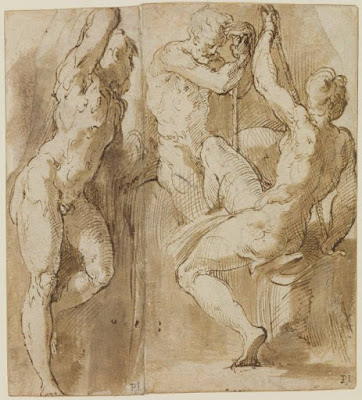 |
| Parmigianino Self-portrait at age 20 ca. 1524 drawing Royal Collection, Windsor |
 |
| Parmigianino Head of a youth before 1540 drawing British Museum |
 |
| Parmigianino Madonna of the Long Neck ca. 1534-40 oil on panel Galleria degli Uffizi, Florence |
"Both the excessive lengthening of the figure, and the neglectfulness in the handling of space, are acutely emphasized for the first time in a somewhat later painting, the famous, because especially charming, Madonna of the Long Neck (about 1535 to 1540). Here the elongation of the body is more thoroughgoing in that it does not involve the massive giantesses of Rosso, still partially visible in Parmigianino's own Vision of St. Jerome [directly below], but instead, a slim, elegant lady, an aristocrat, even more distinguished and courtly than Correggio's female saints. This uncanonical elongation enhances still further the elegance and the gracefully and carefully posed effect of the twisted position. The artistic method is the same, but the new proportions have a quite different meaning than in the ascetic Pontormo or in the excited Rosso. The angels have the same elegant grace, and the overlong nude leg of the youthful angel at the front, with the vase half cut off by the frame, carries a quite special accent."
"The spatial relations are astonishing. The group of the Virgin with the angels in front of the red curtain is set very high and off to one side; the eye must shift without transition into a deeper space where a column rises and a prophet, much too small in proportion to the group of the Virgin, stands holding a scroll. It is the same evocation of intentionally unrealistic proportions in the sizes of the figures, in their relation to each other and in their positions in space . . . Thus the Florentines did not (as has been suggested) take over Mannerism from Parmigianino; on the contrary, as is only natural considering his relative youth, he learned from the anticlassical movement of Pontormo and Rosso precisely those things that distinguish him from the preceding generation – the subjective rhythmic quality of his art, the uncanonical presentation of the figure, demonstrated in verticalism and in other elements, and the equally uncanonical handling of space."
 |
| Parmigianino Vision of St Jerome with St John the Baptist, and the Madonna and Child 1526-27 oil on panel National Gallery, London |
"Thus only a little later than Rosso and Pontormo, Parmigianino underwent the same transformation of style. In the harder Roman atmosphere the grace and softness of the Correggesque style is altered into a harder and stiffer structure, and from the delicate court ladies of Correggio develop heroines who, to be sure, are still graceful. This appears decisively in the one masterpiece of the Roman period which is preserved to us, the Vision of St. Jerome, especially its upper part, for the lower still shows a debt to Correggio."
"In contrast to the optical weaving of the figures, the sfumato, the lovely softness of the women of Correggio, Parmigianino's composition is reduced to only a few figures with sharper contours, and the figure of the Madonna is of an outspoken monumentality. This is the attitude found in the later Raphael, in Sebastiano, in Michelangelo. But it is characteristic that the Michelangelo of the Sistine apparently exercised little influence on Parmigianino. The motif of the Madonna with the beautiful boy between her knees stems indeed from Michelangelo, but it goes back to a youthful work of the master, the Madonna of Bruges. Thus the placing of the Madonna is completely frontal. To this extent, and likewise in the type, the painting recalls the "classic" feeling. What makes it more modern and anticlassic – in addition to its neglect of the spacial element – is its verticalism. Its frontality emphasizes its utterly unusual format, much more than twice as high as it is wide, a proportion we must recognize as offering an extreme contrast to Renaissance feeling, absolutely dedicated to balancing every relationship."
– Walter Friedlaender, from Mannerism and Anti-Mannerism in Italian Painting (Columbia University Press, 1957 – translated from texts originally published in German in the 1920s, when the rehabilitation of the Mannerist reputation was still a daring novelty)
 |
| Parmigianino Seated woman holding statuette of Victory before 1540 drawing Cincinnati Art Museum |
 |
| Parmigianino Mystic Marriage of St Catherine ca. 1525-26 drawing Real Academia de Bellas Artes de San Fernando, Madrid |
 |
| Parmigianino Mystic Marriage of St Catherine ca. 1527-31 oil on panel National Gallery, London |
 |
| Parmigianino Three Figures before 1540 drawing British Museum |
 |
| Parmigianino Seated figure of Mercury ca. 1525 drawing Metropolitan Museum of Art, New York |
 |
| Parmigianino Winged Victories ca. 1531-35 drawing Princeton University Art Museum |
 |
| Parmigianino Two studies for the Holy Family 1526 drawing Getty Museum, Los Angeles |
 |
| Parmigianino Entombment ca. 1525-27 oil on panel (grisaille) Blanton Museum of Art, Austin, Texas |
 |
| Parmigianino Entombment ca. 1527-30 etching Blanton Museum of Art, Austin, Texas |
 |
| Parmigianino Cupid carving his bow ca. 1534-35 oil on panel Kunsthistorisches Museum, Vienna |